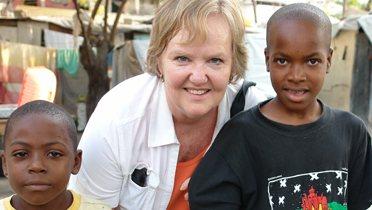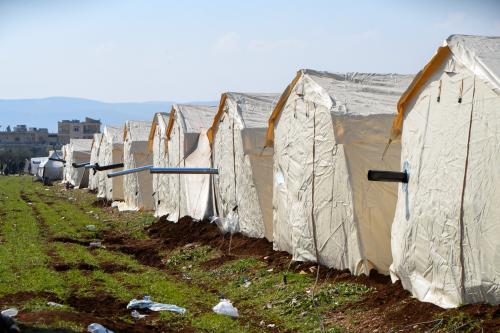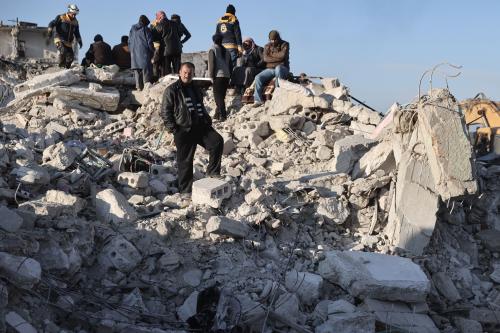Travel in Haiti isn’t easy. There aren’t any taxis. The streets in Port-au-Prince are terribly bad — deep fissures everywhere, potholes the size of my bathroom, piles of earthquake rubble lining the edges of the streets and often big piles in the middle of the streets. I’ve been on many terrible roads in Africa, but this is the worst I’ve seen in a city. The traffic, of course, is terrible. It takes 3 1/2 to 4 hours to drive across the city. The five days I spent in Haiti were largely spent in the front seat of a bouncing jeep. I had a full schedule of meetings with U.N. and U.S. government aid workers and both Haitian and international NGOs. I went to Haiti to look at the situation of internally displaced persons (IDPs) and to try to understand why it’s so difficult to find solutions for the people living in the 1,000 or so camps in Port-au-Prince.
You can’t miss the camps. They’re everywhere. Anywhere there was an open space after the earthquake is now filled with clusters of tents in varying stages of disrepair. In some ways they look like refugee camps — women washing clothes, men sitting around, kids kicking balls in the dust — but rather than being in isolated rural areas, they’re sandwiched between gas stations, stands selling charcoal, and piles of rubble spilling on to the streets, remnants of houses toppled by the earthquake. But the IDP camps are not populated only by people who lost their homes in the earthquake. Lots of people — who knows how many — have come to the camps because services are better than in urban slums. There’s no free food in the camps, but they generally have water. The camps have tarps or tents, even if they are pretty tattered after a year of use. There is a chance that a child living in a camp might be able to go to school or get antibiotics if they’re sick. “People want to be IDPs,” someone said told me. “It’s so much better than what they had.” It’s an indication of how desperate urban poverty is in Haiti that IDP camps are seen as preferred living options.
One afternoon I met with members of a Haitian NGO, called KOFAVIV, which works with 60 women “agents” — all of whom have been victims of sexual violence. The women work in the camps trying to prevent other attacks on women. The police are nowhere to be found. There is no electricity, and as a result, no lights. Women are raped every night when they go to the latrines. The main defense they’ve come up with are whistles — when a woman is threatened, she blows a whistle and other women come running out to try to stop the thugs. “The victims are getting younger,” one 15-year old KOFAVIV “agent” told me. “Orphan girls aged 5-7 are particularly at risk,” she said. Sadly, prostitution is growing, particularly among young girls. They get 50 cents a trick, I was told, and there is nowhere else an orphan can earn 50 cents or other means of support.
At the insistence of NGOs and UN agencies working in the Protection Cluster, the police arm of MINUSTAH (UN Stabilization Mission in Haiti) has begun to patrol those camps at greatest risk of violence. But their resources are limited; in fact, they’re only able to patrol a tenth of the IDP camps, and even then, “patrolling” only means driving around the perimeter of the camp once or twice a month. Not much protection for women living in flimsy tents where predators come out at night.
I had many meetings with humanitarian workers — all good people, pouring their hearts into the work, but conscious that it’s not enough, not nearly enough. It’s an impossible situation. They go into a camp and try to work through local IDP committees, but then discover that the “representative” committees are self-selected and often not at all representative of the camp’s inhabitants. Sometimes committee members don’t even live in the camps. Even with these significant shortcomings, these committees determine who in the camps receive assistance. “We see particularly vulnerable people, like 80 and even 90-year old women who have nothing. We want to give them food rations, but the committees say ‘no you can’t single out people and if you give the old women food, they will be beaten and robbed,’” said a protection coordinator of a major NGO.
I was amazed at how frankly and how often people talk about defecation. Feces. USAID has provided latrines — porta-potties — for many of the camps, but these facilities are not sustainable. They need to be desludged (terrible word), people don’t keep them clean, and they’re sites of violence. Private owners of the land where the IDPs live (understandably) don’t want permanent latrines dug, so the only options are the portable toilets. The preferred alternative, I’m told, is to go back to what people did in urban slums before the earthquake — provide plastic bags for people to defecate in and find a better way of disposing of them than throwing them in the nearest ravine. I’m struck by the contrast between the rhetoric of “building back better” and the thought of millions of plastic bags of feces being produced every day. I’ve had hundreds of conversations about “watsan” (water & sanitation) over the years, but this is the first time the discussions have been this widespread — and this graphic.
The humanitarian workers I talk with are all worried about the news reports likely to come around the one year anniversary. “The international community didn’t perform well,” a very experienced NGO rep said. “We made lots of mistakes and people are paying for it.” But what no one is saying, and everyone is perhaps afraid to say, is that the Haitian government is largely absent when decisions are needed. They don’t show up for meetings, they don’t make decisions, they’re focused solely on the elections. Some mayors and municipal authorities are trying to help, but often they don’t have the authority to make needed decisions. The rubble hasn’t been removed because the government hasn’t identified sites to dump the stuff. Customs is a travesty — goods are held in storage for months — because there are economic “interests” at play. I’m told of the case of an NGO which couldn’t get its trucks out of customs for months — and had to pay hundreds of thousands of dollars to rent vehicles. It turns out the rental car agencies are in cahoots with the customs authorities. But the government gets 67 percent of its revenues from customs taxes, so of course there are economic interests to maximize revenues. Where else will the government get the revenues it so desperately needs? Property taxes — when only a small percentage of the land is legally registered? Income taxes when at least 80% of the population is unemployed? Sales tax when most of the transactions are carried out by illiterate people on the street?
“OK, Beth, let me ask you to make a guess,” a donor government representative official asked me. “What percentage of Haiti’s population has completed high school, including taking the mandatory end-of-high school test?” “Twenty percent?” I ventured, knowing it would be low. “Less than one percent,” he said. “Actually, it’s 0.8 percent.” What does that tell you about prospects for recovery?
The international presence is visible as evidenced by the legions of white four-wheel drive vehicles, many with a bold UN letters printed in black, others with marked with the acronyms of aid agencies. A visible sign of the international community’s concern. At some intersections where dozens of vehicles are gridlocked, you can identify the non-international vehicles on one hand. It reminds me of Cambodia in 1992 where I was amazed at the number of white Toyotas transporting relief workers. Like 1992 Cambodia, there’s popular resentment here at all this display of wealth in a land of desperate poverty. These vehicles cost at least $30-$40,000 each in a city where half the population makes less than $1 a day. But there’s no other way to get around.
The Logbase is the site at the airport constructed for the relief effort. It’s the home of MINUSTAH, UN agencies and other international agencies. It is surreal. The closest analogy is a temporary military base. There are new prefab containers everywhere — offices, barracks, stores. Military acronyms are interspersed with UN logos. The Chilean air force, IOM, the Japanese contingent, UNDP, the Uruguayan battalion, UNICEF. My driver let me off at the entrance to the Logbase, and I waited in line for 20 minutes to enter (I was the only woman, the only white person in the line). MINUSTAH security guards the entrance, and the bureaucracy is painfully slow. I had fixed appointments, I had my U.S. passport in hand, but the guard’s window was small and high, making it hard to hear the guard asking for information. Over and over again I said, in what I thought was at least passable French, “I have a meeting with M. Majekodunmi, Droits de l’Homme. He’s expecting me.” I never understood/heard the response through that high window, even though I leaned close to feel the cool air from the window on my face. “Do you have much Haitian participation in your coordination meetings,” I asked when I finally was able to find the protection cluster coordinator. “No,” he answered, “and it’s a shame.” His colleague chimed in “sometimes they get stuck like you did at security and have trouble finding us. Our meetings are only an hour long and the Haitians — who don’t have UN IDs — tend to arrive late. I think after three or four times they don’t think it’s worth it.” This is something I totally understand.
While walking through a camp of 1,800 displaced families, I ask the representative of the camp committee whether Haitian government officials visited the camp. “Never,” she said. “What about the mayor or other municipal authorities?” “No.” Another day, I talk with a Haitian pastor who heads a council of some 8,000 churches. “We’ve been totally excluded from the relief effort. Who knows what all these internationals are doing? It’s a new occupation of Haiti.” Certainly the NGOs are providing needed services, services the government can’t provide. Everyone recognizes that international effort substituting for the government lets political authorities off the hook. But what’s the alternative?
It’s all terribly complicated. There are no easy answers or even clear villains.
As I wait in air conditioned comfort for my flight back to the United States, I wonder how many women will blow whistles when they’re attacked in the dark camps tonight and how many won’t even have whistles to blow.



